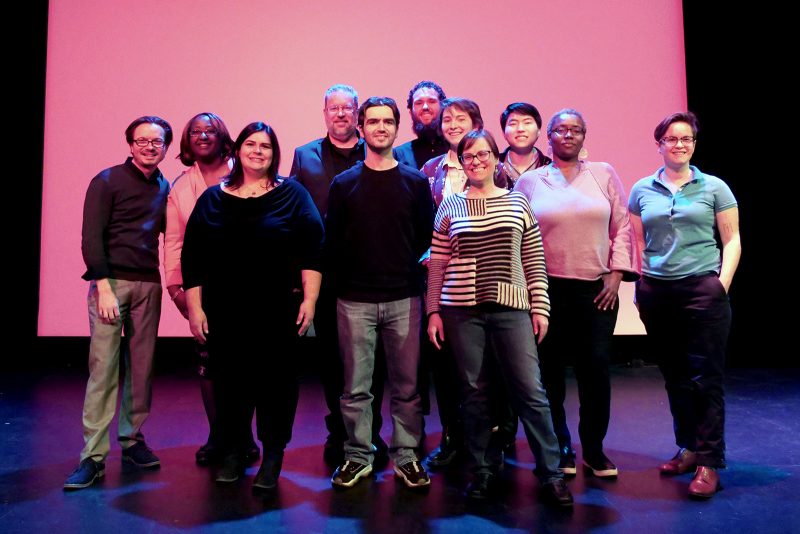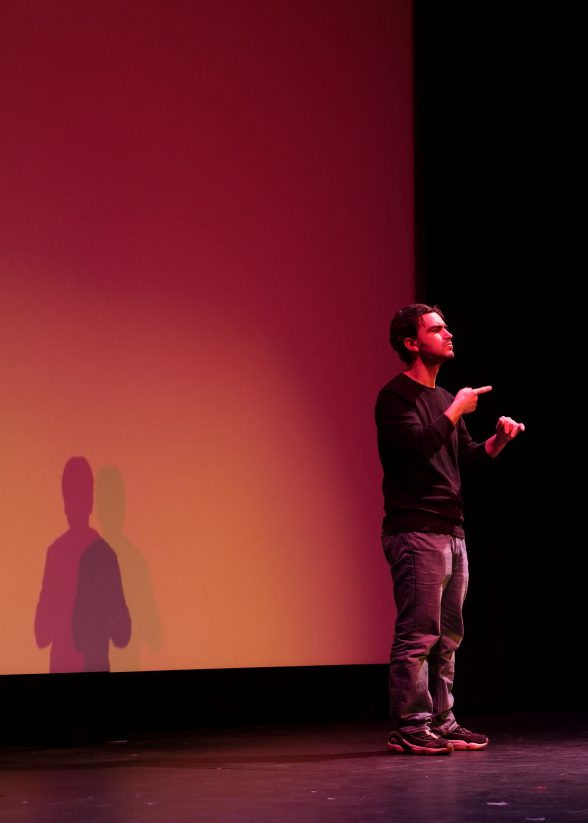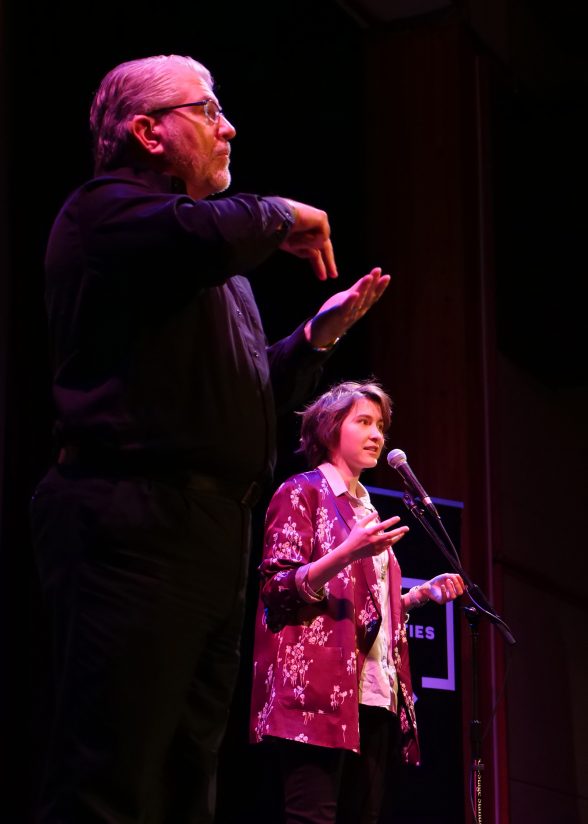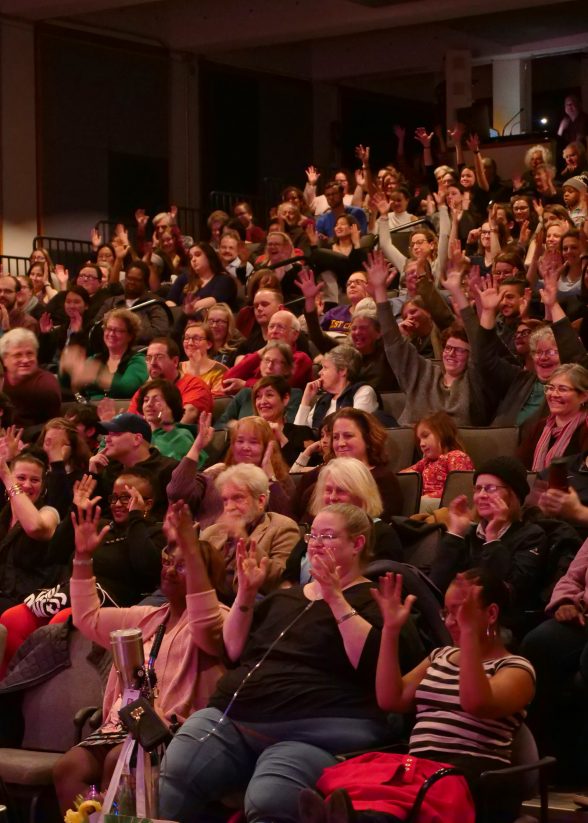A Story Slam with a difference, Rebirths, Returns, and Comebacks at the International House broadened my understanding of language as it relates to people who are deaf or hard of hearing. The March 27th event, which featured ten local storytellers, half of whom were deaf, was sponsored by the University of Pennsylvania’s Wolf Humanities Center as a part of their 2017-18 programming on the theme of “Afterlives.” I want to tell you about the performance, and about the further digging it compelled me to do. I also want to express my gratitude to Jami N. Fisher, Ed.D., the ASL Program Coordinator in the Department of Linguistics at the University of Pennsylvania, where students can fulfill their “foreign” language requirement by studying ASL. Jami led me into the thicket, and then patiently explained my surroundings.

Image courtesy of Sarah Milinski / Wolf Humanities Center.
The International House’s 360-seat Ibrahim Theater was filled for the program, and a good half of the audience was comprised of deaf people. Stories were told in ASL and in spoken English, with interpreters making them accessible to all. Each of the stories involved overcoming hardships, some related to deafness, others generated by the condition of being human in our society — dealing with illness, fitting in, helplessness, obesity, suicide, finding home. All of them were poignant and heartfelt. What I found remarkable, however, were the challenges described by deaf presenters who were denied the opportunity to learn ASL during their formative years. It was their stories, which seemed to resonate most strongly with the audience, that impelled me to learn more. I’ve included here a picture (bottom image) of the crowd – those with their arms raised are shaking their hands, clapping in ASL – to give you a sense of the energy in the room.
The signing itself seemed almost a form of dance. As I sat there, captivated by the evocative beauty of ASL, I wondered whether it was possible for a signed language to capture all of the details, vocabulary, and nuances of spoken English. I left the event determined to find out more. What I discovered afterward, both linguistically about ASL, and about the history of education of the deaf in this country, amazed me.
American Sign Language
Sign languages are visual languages with their own unique rules of grammar and syntax, in which information is conveyed by the shape, placement, and movement of the hands, as well as facial expressions and body movements. Like all complex languages, sign languages grow and evolve. There are over two hundred sign languages in use around the world today, with ASL being used predominantly in the United States and Canada,
Sign languages are organized in the brain just like spoken languages are. Deaf children exposed to sign languages go through the same stages of language acquisition as hearing children. Indeed, very young deaf children babble with their hands. People for whom sign is their primary language think in signs.
ASL accordingly is a complete language, fully capable of the sophisticated interpretation of spoken English. Indeed, it is a form of expression, in three dimensions, which, in certain respects, may be more versatile than spoken English.
Controversy in the education of the deaf
Although none of the deaf presenters at Rebirths, Returns, and Comebacks spoke, a number of their signed stories involved the efforts of parents and educators to teach them to speak during their formative years. They were taught to lip-read, and they used various, sometimes primitive, audiological devices. However, they were discouraged from signing. A number of those storytellers recounted being labeled as learning disabled, and it was not until they were older and learned ASL that they were fully able to learn and communicate.

Until the second half of the 20th century, the education of the deaf in America was dominated by a movement, termed “oralism,” in which deaf children were compelled to learn to speak and to lip-read, with the assistance of auditory aids, and signing was prohibited. The goal of oralism, purportedly, was to enable deaf people to fit into and communicate with the hearing community. The movement was led by the likes of Alexander Graham Bell, and it was instituted with missionary zeal by its advocates. I was shocked to learn that in some oralist schools, children’s hands were bound to prevent them from signing. Ultimately, however, it was impossible to prevent deaf children from using sign language. They kept their language alive by signing with each other in private.
While oralism still prevails in many settings, there has been a resurgence of the competing philosophy of “manualism” in the education of the deaf, based upon the primacy of sign language. Led by Gallaudet University founder Edward Miner Gallaudet, these educators recognized that because it is so challenging for deaf children to learn to speak (particularly children deaf from birth), and because lip-reading English is particularly inefficient (lip readers barely discern 30% of spoken English), strict oralism was holding many children back. Manualists accordingly combined sign language with spoken language and other communication tools in their programs, which were more flexible, holistic, and compassionate.

Cochlear implants, electronic devices that deliver a “sense of sound” to certain deaf and hard of hearing individuals, are a developing technology, clearly with great potential to assist many people to communicate. Oralists seem to have embraced this technology wholeheartedly. ASL educators, on the other hand, have incorporated it into their arsenal of communication tools, while retaining ASL as the primary means of communication in their programs.
It’s worth noting with respect to these controversies that many people in the Deaf community, and particularly many ASL advocates, remain concerned that educational philosophies such as oralism, and technological interventions such as cochlear implants, pathologize deafness, define and identify deaf individuals primarily by their deafness, and ultimately marginalize them.
The issue of accessibility
While the exact number of people who are deaf or hard of hearing in the United States is difficult to estimate, one thing that became very clear to me at Rebirths, Returns, and Comebacks is that there exists, largely out of the public eye, a vibrant, affirming, supportive Deaf community, the foundation of which is ASL.

Deaf communities are usually insular, and develop their own cultures, because so much of the speaking world is inaccessible to them. Events like the one I attended compellingly suggest that while recognizing and respecting the autonomy of Deaf communities and cultures, we should be devoting substantially more resources to increasing overall accessibility, and particularly to enabling the deaf and hard of hearing to take advantage of educational and employment opportunities in the hearing community. I was pleased recently to learn, for example, that the Metropolitan Museum in New York offers both live and internet-based tours of its exhibitions in ASL.
Overcoming hardships
I felt honored to witness an event in which both deaf and hearing individuals stood side by side in recounting their stories of rebirths, returns, and comebacks. It reminded me that human beings are united in their similarities and enriched by appreciating their differences.
Rebirths, Returns, and Comebacks, which you can hear, was produced by the Wolf Humanities Center in collaboration with Kelly Writers House, the University of Pennsylvania’s American Sign Language Program, and the Deaf-Hearing Communication Center. The event was hosted by the talented ASL advocate and performer Wink Smith, Jr.





